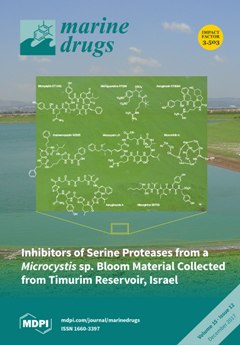A previously unreported dihydrochromone dimer, paecilin E (
1), was isolated, together with eleven known compounds: β-sitostenone, ergosta-4,6,8 (14), 22-tetraen-3-one, cyathisterone, byssochlamic acid, dehydromevalonic acid lactone, chevalone B, aszonalenin, dankasterone A (
2), helvolic acid, secalonic acid A and fellutanine A,
[...] Read more.
A previously unreported dihydrochromone dimer, paecilin E (
1), was isolated, together with eleven known compounds: β-sitostenone, ergosta-4,6,8 (14), 22-tetraen-3-one, cyathisterone, byssochlamic acid, dehydromevalonic acid lactone, chevalone B, aszonalenin, dankasterone A (
2), helvolic acid, secalonic acid A and fellutanine A, from the culture filtrate extract of the marine sponge-associated fungus
Neosartorya fennelliae KUFA 0811. Nine previously reported metabolites, including a chromanol derivative (
3), (3β, 5α, 22
E), 3,5-dihydroxyergosta-7,22-dien-6-one (
4), byssochlamic acid, hopan-3β,22-diol, chevalone C, sartorypyrone B, helvolic acid, lumichrome and the alkaloid harmane were isolated from the culture of the marine-sponge associated fungus
Neosartorya tsunodae KUFC 9213. Paecilin E (
1), dankasterone A (
2), a chromanol derivative (
3), (3β, 5α, 22
E)-3,5-dihydroxyergosta-7,22-dien-6-one (
4), hopan-3β,22-diol (
5), lumichrome (
6), and harmane (
7) were tested for their antibacterial activity against Gram-positive and Gram-negative reference and multidrug-resistant strains isolated from the environment. While paecilin E (
1) was active against
S. aureus ATCC 29213 and
E. faecalis ATCC 29212, dankastetrone A (
2) was only effective against
E. faecalis ATCC 29212 and the multidrug-resistant VRE
E. faecalis A5/102. Both compounds neither inhibit biofilm mass production in any of the strains at the concentrations tested nor exhibit synergistic association with antibiotics.
Full article






